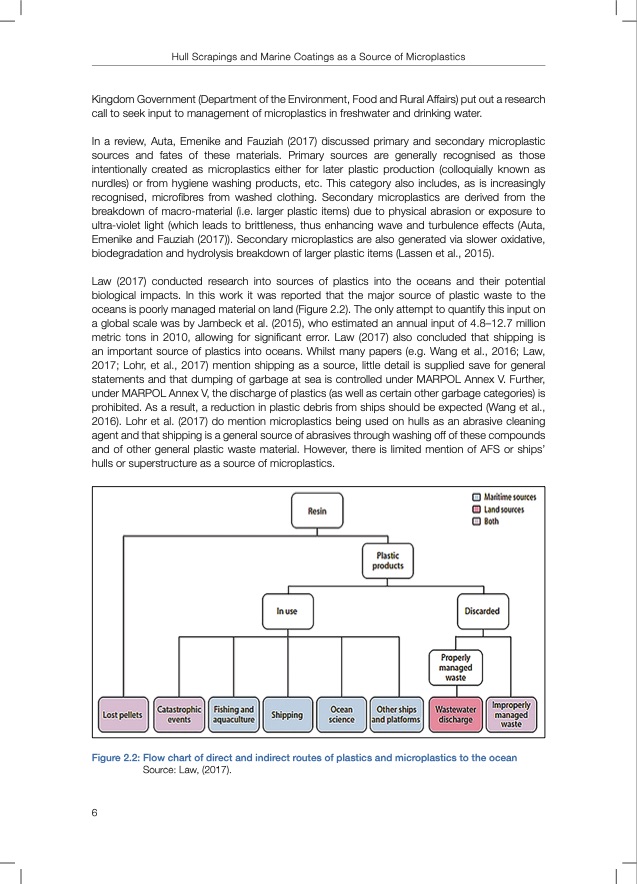
PDF Publication Title:
Text from PDF Page: 015
Hull Scrapings and Marine Coatings as a Source of Microplastics Kingdom Government (Department of the Environment, Food and Rural Affairs) put out a research call to seek input to management of microplastics in freshwater and drinking water. In a review, Auta, Emenike and Fauziah (2017) discussed primary and secondary microplastic sources and fates of these materials. Primary sources are generally recognised as those intentionally created as microplastics either for later plastic production (colloquially known as nurdles) or from hygiene washing products, etc. This category also includes, as is increasingly recognised, microfibres from washed clothing. Secondary microplastics are derived from the breakdown of macro-material (i.e. larger plastic items) due to physical abrasion or exposure to ultra-violet light (which leads to brittleness, thus enhancing wave and turbulence effects (Auta, Emenike and Fauziah (2017)). Secondary microplastics are also generated via slower oxidative, biodegradation and hydrolysis breakdown of larger plastic items (Lassen et al., 2015). Law (2017) conducted research into sources of plastics into the oceans and their potential biological impacts. In this work it was reported that the major source of plastic waste to the oceans is poorly managed material on land (Figure 2.2). The only attempt to quantify this input on a global scale was by Jambeck et al. (2015), who estimated an annual input of 4.8–12.7 million metric tons in 2010, allowing for significant error. Law (2017) also concluded that shipping is an important source of plastics into oceans. Whilst many papers (e.g. Wang et al., 2016; Law, 2017; Lohr, et al., 2017) mention shipping as a source, little detail is supplied save for general statements and that dumping of garbage at sea is controlled under MARPOL Annex V. Further, under MARPOL Annex V, the discharge of plastics (as well as certain other garbage categories) is prohibited. As a result, a reduction in plastic debris from ships should be expected (Wang et al., 2016). Lohr et al. (2017) do mention microplastics being used on hulls as an abrasive cleaning agent and that shipping is a general source of abrasives through washing off of these compounds and of other general plastic waste material. However, there is limited mention of AFS or ships’ hulls or superstructure as a source of microplastics. Figure 2.2: Flow chart of direct and indirect routes of plastics and microplastics to the ocean Source: Law, (2017). 6PDF Image | HULL SCRAPINGS AND MARINE COATINGS AS A SOURCE OF MICROPLASTICS

PDF Search Title:
HULL SCRAPINGS AND MARINE COATINGS AS A SOURCE OF MICROPLASTICSOriginal File Name Searched:
Hull-Scrapings-report.pdfDIY PDF Search: Google It | Yahoo | Bing
Development of a solar powered Electric Ship The Electricship website originally started off as a project to develop a comprehensive renewable, affordable, modular electric ship... More Info
Modular Boat Hull Composite The case for a unsinkable, modular composite hybrid boat hull... More Info
MS Burgenstock Hybrid Electric Catamaran Lake Lucerne Unique shuttle servicing Lucerne to the Burgenstock Resort... More Info
Ground Power Unit GPU Powered by Lithium Ion Batteries The goal of the Ground Power Unit is to provide a readily accessible, modular, ready-to-power solution for remote power... More Info
| CONTACT TEL: 608-238-6001 Email: greg@electricship.com | RSS | AMP |